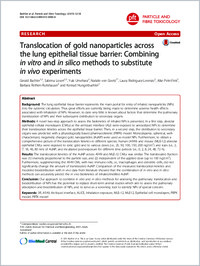Translocation of gold nanoparticles across the lung epithelial tissue barrier: Combining in vitro and in silico methods to substitute in vivo experiments.
- Bachler G ETH Zürich, Institute for Chemical and Bioengineering, 8093, Zürich, Switzerland. gerald.bachler@chem.ethz.ch.
- Losert S ETH Zürich, Institute for Chemical and Bioengineering, 8093, Zürich, Switzerland. sabrina.losert@empa.ch.
- Umehara Y University of Fribourg, Adolphe Merkle Institute, 1700, Fribourg, Switzerland. yuki.umehara@unifr.ch.
- von Goetz N ETH Zürich, Institute for Chemical and Bioengineering, 8093, Zürich, Switzerland. natalie.von.goetz@chem.ethz.ch.
- Rodriguez-Lorenzo L University of Fribourg, Adolphe Merkle Institute, 1700, Fribourg, Switzerland. laura.rodriguez-lorenzo@unifr.ch.
- Petri-Fink A University of Fribourg, Adolphe Merkle Institute, 1700, Fribourg, Switzerland. alke.fink@unifr.ch.
- Rothen-Rutishauser B University of Fribourg, Adolphe Merkle Institute, 1700, Fribourg, Switzerland. barbara.rothen@unifr.ch.
- Hungerbuehler K ETH Zürich, Institute for Chemical and Bioengineering, 8093, Zürich, Switzerland. konrad.hungerbuehler@chem.ethz.ch.
- 2015-06-28
Published in:
- Particle and fibre toxicology. - 2015
Administration, Inhalation
Aerosols
Animals
Biological Transport
Cell Line, Tumor
Computer Simulation
Epithelial Cells
Gold Compounds
Humans
Metal Nanoparticles
Mice
Models, Biological
Particle Size
Respiratory Mucosa
Tissue Distribution
English
BACKGROUND
The lung epithelial tissue barrier represents the main portal for entry of inhaled nanoparticles (NPs) into the systemic circulation. Thus great efforts are currently being made to determine adverse health effects associated with inhalation of NPs. However, to date very little is known about factors that determine the pulmonary translocation of NPs and their subsequent distribution to secondary organs.
METHODS
A novel two-step approach to assess the biokinetics of inhaled NPs is presented. In a first step, alveolar epithelial cellular monolayers (CMLs) at the air-liquid interface (ALI) were exposed to aerosolized NPs to determine their translocation kinetics across the epithelial tissue barrier. Then, in a second step, the distribution to secondary organs was predicted with a physiologically based pharmacokinetic (PBPK) model. Monodisperse, spherical, well-characterized, negatively charged gold nanoparticles (AuNP) were used as model NPs. Furthermore, to obtain a comprehensive picture of the translocation kinetics in different species, human (A549) and mouse (MLE-12) alveolar epithelial CMLs were exposed to ionic gold and to various doses (i.e., 25, 50, 100, 150, 200 ng/cm(2)) and sizes (i.e., 2, 7, 18, 46, 80 nm) of AuNP, and incubated post-exposure for different time periods (i.e., 0, 2, 8, 24, 48, 72 h).
RESULTS
The translocation kinetics of the AuNP across A549 and MLE-12 CMLs was similar. The translocated fraction was (1) inversely proportional to the particle size, and (2) independent of the applied dose (up to 100 ng/cm(2)). Furthermore, supplementing the A549 CML with two immune cells, i.e., macrophages and dendritic cells, did not significantly change the amount of translocated AuNP. Comparison of the measured translocation kinetics and modeled biodistribution with in vivo data from literature showed that the combination of in vitro and in silico methods can accurately predict the in vivo biokinetics of inhaled/instilled AuNP.
CONCLUSION
Our approach to combine in vitro and in silico methods for assessing the pulmonary translocation and biodistribution of NPs has the potential to replace short-term animal studies which aim to assess the pulmonary absorption and biodistribution of NPs, and to serve as a screening tool to identify NPs of special concern.
The lung epithelial tissue barrier represents the main portal for entry of inhaled nanoparticles (NPs) into the systemic circulation. Thus great efforts are currently being made to determine adverse health effects associated with inhalation of NPs. However, to date very little is known about factors that determine the pulmonary translocation of NPs and their subsequent distribution to secondary organs.
METHODS
A novel two-step approach to assess the biokinetics of inhaled NPs is presented. In a first step, alveolar epithelial cellular monolayers (CMLs) at the air-liquid interface (ALI) were exposed to aerosolized NPs to determine their translocation kinetics across the epithelial tissue barrier. Then, in a second step, the distribution to secondary organs was predicted with a physiologically based pharmacokinetic (PBPK) model. Monodisperse, spherical, well-characterized, negatively charged gold nanoparticles (AuNP) were used as model NPs. Furthermore, to obtain a comprehensive picture of the translocation kinetics in different species, human (A549) and mouse (MLE-12) alveolar epithelial CMLs were exposed to ionic gold and to various doses (i.e., 25, 50, 100, 150, 200 ng/cm(2)) and sizes (i.e., 2, 7, 18, 46, 80 nm) of AuNP, and incubated post-exposure for different time periods (i.e., 0, 2, 8, 24, 48, 72 h).
RESULTS
The translocation kinetics of the AuNP across A549 and MLE-12 CMLs was similar. The translocated fraction was (1) inversely proportional to the particle size, and (2) independent of the applied dose (up to 100 ng/cm(2)). Furthermore, supplementing the A549 CML with two immune cells, i.e., macrophages and dendritic cells, did not significantly change the amount of translocated AuNP. Comparison of the measured translocation kinetics and modeled biodistribution with in vivo data from literature showed that the combination of in vitro and in silico methods can accurately predict the in vivo biokinetics of inhaled/instilled AuNP.
CONCLUSION
Our approach to combine in vitro and in silico methods for assessing the pulmonary translocation and biodistribution of NPs has the potential to replace short-term animal studies which aim to assess the pulmonary absorption and biodistribution of NPs, and to serve as a screening tool to identify NPs of special concern.
- Language
-
- English
- Open access status
- gold
- Identifiers
-
- DOI 10.1186/s12989-015-0090-8
- PMID 26116549
- Persistent URL
- https://sonar.ch/global/documents/57963
Statistics
Document views: 14
File downloads:
- fulltext.pdf: 0
